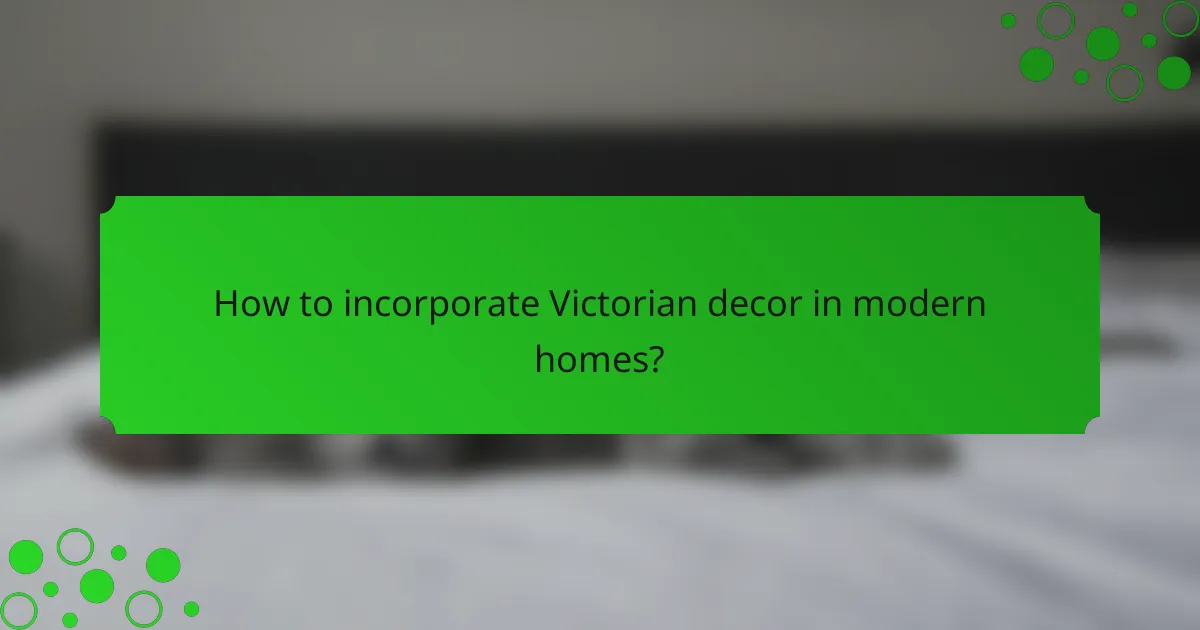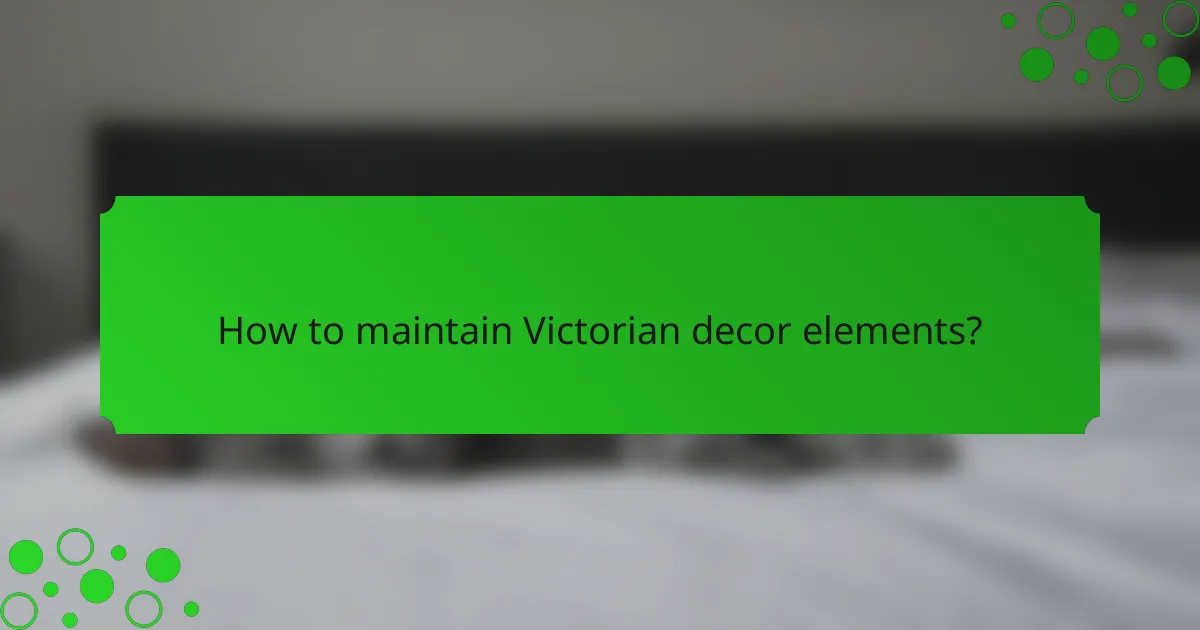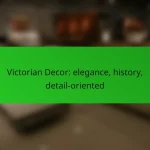Victorian decor embodies a unique blend of elegance and history, characterized by its ornate details and rich color palettes. Emerging during the reign of Queen Victoria in the 19th century, this design style reflects a deep appreciation for craftsmanship and opulence. By incorporating Victorian elements into modern spaces, one can achieve a sophisticated aesthetic that pays homage to this timeless era.

How to incorporate Victorian decor in modern homes?
Incorporating Victorian decor into modern homes involves blending historical elegance with contemporary design elements. Focus on rich textures, ornate details, and a cohesive color palette to achieve a sophisticated look that honors the Victorian era.
Use of rich fabrics
Rich fabrics are a hallmark of Victorian decor, adding depth and warmth to any space. Consider using materials like velvet, brocade, and damask for upholstery, curtains, and cushions. These fabrics not only enhance visual appeal but also create a luxurious atmosphere.
When selecting fabrics, aim for deep jewel tones or intricate patterns that reflect the opulence of the Victorian period. Mixing textures can also add interest; for example, pair a velvet sofa with silk or lace throw pillows for a layered effect.
Incorporating antique furniture
Antique furniture is essential for achieving an authentic Victorian look. Look for pieces made from dark woods, such as mahogany or walnut, featuring intricate carvings and ornate details. Items like tufted armchairs, large dining tables, and decorative cabinets can serve as focal points in your rooms.
While sourcing antique furniture, consider visiting local flea markets, estate sales, or specialized antique shops. Ensure that the pieces you choose complement each other and fit the scale of your space to avoid overwhelming the room.
Choosing ornate lighting fixtures
Ornate lighting fixtures can dramatically enhance the Victorian aesthetic in your home. Look for chandeliers made from crystal or wrought iron, as well as sconces with intricate designs. These fixtures not only provide illumination but also serve as stunning decorative elements.
When selecting lighting, consider the size of the room and the height of the ceilings. A large chandelier can become a statement piece in a dining room, while smaller sconces can add charm to hallways or reading nooks.
Utilizing bold wallpaper patterns
Bold wallpaper patterns are a defining feature of Victorian decor, often showcasing floral or damask designs. Opt for wallpapers with rich colors and intricate patterns to create a sense of drama and elegance in your spaces.
Consider using wallpaper on a feature wall or in smaller rooms to avoid overwhelming the space. Additionally, pairing patterned wallpaper with solid-colored furnishings can help balance the overall look while maintaining the Victorian charm.
Integrating decorative moldings
Decorative moldings are crucial for adding architectural interest reminiscent of the Victorian era. Crown moldings, wainscoting, and chair rails can enhance the elegance of your home while providing a polished finish to your interiors.
When installing moldings, choose styles that reflect the period’s characteristics, such as intricate designs or bold profiles. Painting them in contrasting colors can also highlight their details and create a striking visual effect.

What are the key characteristics of Victorian decor?
Victorian decor is defined by its emphasis on ornate details, rich colors, and a blend of various styles. This design aesthetic emerged during the reign of Queen Victoria in the 19th century and reflects a fascination with craftsmanship and opulence.
Emphasis on intricate details
Victorian decor is renowned for its intricate details, which can be seen in furniture, textiles, and architectural elements. Carved woodwork, elaborate moldings, and decorative patterns are common features that create a sense of luxury and sophistication.
When incorporating intricate details, consider using items like lace curtains, patterned wallpapers, and embellished upholstery. These elements not only add visual interest but also reflect the craftsmanship typical of the Victorian era.
Rich color palettes
The color palettes in Victorian decor are typically rich and deep, featuring jewel tones such as emerald green, ruby red, and royal blue. These colors create a warm and inviting atmosphere, often complemented by gold or brass accents.
To achieve a Victorian-inspired look, opt for bold wall colors or luxurious fabrics in these hues. Pairing darker shades with lighter accents can help balance the overall aesthetic while maintaining the opulence characteristic of this style.
Eclectic mix of styles
Victorian decor is marked by an eclectic mix of styles, combining elements from Gothic, Renaissance, and even Asian influences. This variety allows for a personalized touch, as homeowners can curate pieces that resonate with their tastes while still adhering to the Victorian theme.
When selecting decor, consider mixing furniture and accessories from different periods or cultures, such as a Victorian settee paired with Asian-inspired art. This approach not only honors the Victorian spirit of diversity but also creates a unique and inviting space.

Where to find authentic Victorian decor items in the UK?
Authentic Victorian decor items can be found in various places across the UK, including specialty antique shops, online marketplaces, and local auctions. Each option offers unique advantages, from curated selections to competitive pricing.
Specialty antique shops
Specialty antique shops are excellent sources for authentic Victorian decor, often featuring carefully curated collections. These shops typically have knowledgeable staff who can provide insights into the history and provenance of each piece.
When visiting, look for shops that specialize in Victorian items, as they are more likely to have genuine pieces. Be prepared to invest time in exploring, as inventory can vary significantly from one visit to another.
Online marketplaces like eBay
Online marketplaces such as eBay offer a vast selection of Victorian decor items, making it easy to compare prices and styles. You can find everything from furniture to smaller decorative items, often at competitive prices.
When shopping online, check seller ratings and reviews to ensure authenticity. Use search filters to narrow down results to specific styles or periods, and consider setting alerts for new listings that match your criteria.
Local auctions and estate sales
Local auctions and estate sales can be treasure troves for authentic Victorian decor, often featuring unique items that are not available elsewhere. These events typically allow you to bid on items, which can lead to great deals.
To participate, keep an eye on local listings and auction houses. Arrive early to inspect items and set a budget to avoid overspending. Be aware of any buyer’s premiums or fees that may apply to your final purchase price.

What are the historical influences on Victorian decor?
Victorian decor is shaped by various historical influences, primarily the Industrial Revolution, Gothic Revival, and the reign of Queen Victoria. These elements combined to create a distinctive style characterized by ornate details, rich colors, and a blend of different design traditions.
Impact of the Industrial Revolution
The Industrial Revolution significantly transformed Victorian decor by introducing new materials and manufacturing techniques. Mass production made items like wallpaper, textiles, and furniture more accessible and affordable, allowing for greater experimentation in design.
As a result, homes could be adorned with intricate patterns and elaborate furnishings that were previously reserved for the wealthy. This democratization of design led to a flourishing of decorative arts, with a focus on both aesthetics and functionality.
Influence of Gothic Revival
The Gothic Revival movement played a crucial role in shaping Victorian decor, emphasizing medieval styles and architectural elements. This influence is evident in the use of pointed arches, intricate woodwork, and stained glass, which became popular in both interior and exterior designs.
Victorian homes often featured heavy drapery, dark wood furnishings, and ornate detailing, reflecting the romanticism associated with Gothic architecture. This style appealed to the Victorian fascination with history and the past, creating a sense of nostalgia in home decor.
Role of Queen Victoria in design trends
Queen Victoria’s personal tastes and preferences significantly impacted Victorian decor trends. Her love for elaborate furnishings and attention to detail set a standard that many sought to emulate in their own homes.
Victoria’s influence extended to the promotion of British craftsmanship, which encouraged the use of local artisans and materials. This emphasis on quality and detail became a hallmark of Victorian design, fostering a culture of opulence and refinement in home interiors.

How to maintain Victorian decor elements?
Maintaining Victorian decor elements involves regular cleaning, careful restoration, and an eye for detail. Focus on preserving the intricate designs and rich materials that define this elegant style.
Regular Cleaning Techniques
To keep Victorian decor looking its best, establish a routine cleaning schedule. Use soft, lint-free cloths for dusting ornate furniture and avoid harsh chemicals that can damage delicate finishes.
For fabrics, such as drapes and upholstery, vacuum regularly with a brush attachment to remove dust. Spot clean stains promptly using gentle, fabric-appropriate cleaners to maintain their vibrant colors and textures.
Restoration and Repair Tips
When restoring Victorian elements, prioritize authenticity. Use period-appropriate materials and techniques to ensure repairs blend seamlessly with original features. For example, when refinishing wood, choose stains that match the original hues.
Consider consulting a professional for significant repairs, especially for antique pieces. They can provide expertise in preserving the integrity and value of your decor.
Preserving Original Features
Victorian decor often includes intricate moldings, decorative ceilings, and original flooring. To preserve these features, avoid painting over them unless absolutely necessary. Instead, clean and restore them to highlight their beauty.
For wallpaper, consider using a protective coating to prevent fading and damage. Regularly inspect for signs of wear or moisture damage, addressing issues promptly to maintain the decor’s elegance.










